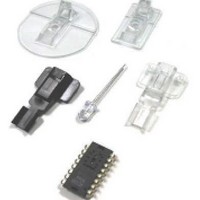ADNK-3061 Avago Technologies US Inc., ADNK-3061 Datasheet - Page 9

ADNK-3061
Manufacturer Part Number
ADNK-3061
Description
KIT REFERENCE DESIGN ADNK-3060
Manufacturer
Avago Technologies US Inc.
Specifications of ADNK-3061
Main Purpose
Reference Design, Optical Mouse
Utilized Ic / Part
ADNS-3060, CY7C63743-PC
Description/function
Optical Mouse Sensor Kit
Interface Type
USB
Product
Display Modules
Touch Panel
No Touch Panel
For Use With/related Products
CY7C63743-PC
Lead Free Status / RoHS Status
Lead free / RoHS Compliant
Lead Free Status / RoHS Status
Lead free / RoHS Compliant, Lead free / RoHS Compliant
USB Functions
usbMain – This routine initializes the USB related parame-
ters and enables VREG to signal the host that the mouse
has been connected. The program then goes to the us-
bTaskLoop .
usbTaskLoop – This function spins in an infinite loop waiting
for an event that needs servicing. The ProcessButtons and
ReadProcessOptics functions are called within this loop
to retrieve any new motion or button information. The
data received from these functions will be loaded into
the endpoint 1 buffer to be sent to the host.
ep0SetupReceived – This routine is entered whenever a
SETUP packet is received on endpoint 0. It parses the
packet and calls the appropriate routine to handle the
packet.
ep0InReceived – This routine is entered whenever an IN
packet is received on endpoint 0.
ep0OutReceived – This routine is entered whenever an OUT
packet is received on endpoint 0.
setDeviceConfiguration – This routine is entered when a SET
CONFIGURATION request has been received from the
host.
setDeviceAddress – This routine is entered whenever a SET
ADDRESS request has been received. The device address
change cannot take place until after the status stage of
this no-data control transaction. So the address is saved
and a flag is set to indicate that a new address was just
received. The code that handles IN transactions will
recognize this and set the address properly.
9
getDescriptor – This routine is entered when a GET DE-
SCRIPTOR request is received from the host. This function
decodes the descriptor request and sends the proper
descriptor.
setInterfaceIdle – This routine is entered whenever a SET
IDLE request is received. See the HID specification for
the rules on setting idle periods. This function sets the
HID idle time. See the HID documentation for details on
handling the idle timer.
setInterfaceProtocol – This routine is entered whenever a
SET PROTOCOL request is received. This no-data control
transaction enables boot or report protocol.
getInterfaceReport – This routine is entered whenever a GET
REPORT request is received.
getInterfaceIdle – This routine is entered whenever a GET
IDLE request is received. This function then initiates a
control-read transaction that returns the idle time. See
the HID class documentation for more details.
getInterfaceProtocol – This routine is entered whenever a
GET PROTOCOL request is received. This request initiates
a control-read transaction that tells the host if the mouse
is configured for boot or report protocol. See the HID
class documentation for more details.
getDeviceConfiguration – This routine is entered whenever a
GET CONFIGURATION Request is received. This function
then starts a control read transaction that sends the con-
figuration, interface, endpoint, and HID descriptors to
the host.
requestNotSupported – Unsupported or invalid descriptor
requests will cause this firmware to STALL these transac-
tions.


















